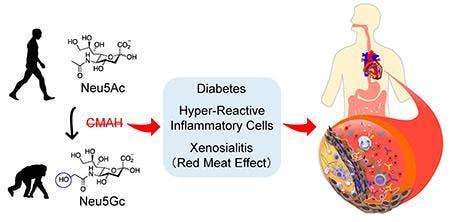
Heart attacks are very common among both humans and chimpanzees, our closest living relatives. However, the causes of sudden cardiac arrest are very different in the two species. For instance, naturally occurring heart attacks due to atherosclerosis — the clogging of arteries due to fatty deposits — is virtually non-existent in other mammals. A new study suggests that the mutation of a gene 2-3 million years ago in our ancestors may explain humans’ high risk for cardiovascular disease.
An estimated 17.9 million people died from CVDs in 2016, representing 31% of all global deaths. Of these deaths, 85% are due to heart attack and stroke.
Nissi Varki, a professor of pathology at the University of California San Diego School of Medicine, and colleagues were intrigued by the prevalence of atherosclerosis — which accounts for one-third of all deaths worldwide due to heart disease. Blood cholesterol, a sedentary lifestyle, old age, obesity, and smoking are all known risk factors that can lead to clogged arteries, but in roughly 15% of cases, none of these factors apply. Even vegetarians with an active lifestyle are prone to heart attacks while our evolutionary relatives are not. Why is that?
In their new study, the researchers engineered mice to be deficient in a sialic acid sugar molecule called Neu5Gc. Previously, the same team found that Neu5Gc deficiency promotes inflammation and cancer progression in mice.
Varki and colleagues found that mice who lost the CMAH gene that produces Neu5Gc had a much higher risk of developing atherogenesis compared to control mice, who retain the gene. A human-like elimination of CMAH caused an almost 2-fold increase in the severity of atherosclerosis, the researchers added.
Writing in the journal PNAS, the UC San Diego scientists say that the gene was likely inactivated by a mutation that occurred a few million years ago in a hominin ancestor. The loss of the gene seems to have also produced other changes in human physiology, including an enhanced ability to run long distances as well as reduced fertility.
“The increased risk appears to be driven by multiple factors, including hyperactive white cells and a tendency to diabetes in the human-like mice,” said Ajit Varki, who is a Professor Of Medicine and Cellular And Molecular Medicine at UC San Diego and co-author of the new study.
Intriguingly, in an experiment where genetically modified mice lacking the CMAH gene were fed a diet analogous to red meat (Neu5Gc-rich, high-fat), the rodents suffered a further 2.4-fold increase in atherosclerosis. This massive increase could not be pinned to blood fats or sugars.
“The human evolutionary loss of CMAH likely contributes to a predisposition to atherosclerosis by both intrinsic and extrinsic (dietary) factors,” wrote the authors, “and future studies could consider using this more human-like model.”






